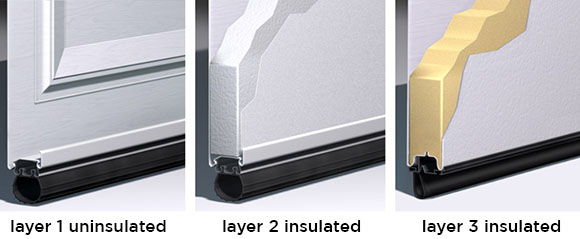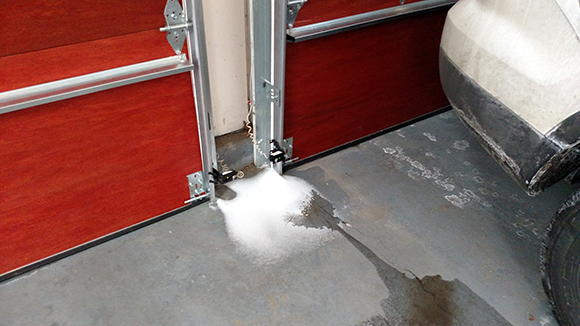What Is Garage Door R-Value?





WITH 3,331 REVIEWS
Click Here To Book Online Now





CLICK
To view local phone numbers

Garage door R-value depends on more than just a number.
Choosing a garage door can be stressful. Not to mention, you’re usually not choosing a door solely because you like its design. You need to factor in price, insulation, R-value, and then find a company to install it properly. This article will help take the guesswork out of garage door shopping because we’re going to discuss insulation, garage door R-value, and what that all means when shopping for a new garage door.
What kind of insulation do you have in your garage?
The first thing to consider is the type of insulation you have in your garage. Do you have sheetrock with insulation behind it or is your garage constructed of concrete blocks? Depending on the type of insulation you currently have in your garage could determine the type of insulation you want to put in your garage door. Putting the best insulated garage door in a garage that isn’t insulated at all will not help with heat loss.
Most homes in the Northeast are constructed using 2x4 construction, sheetrock and fiberglass insulation, which would put the garage door R-value of your walls at about an R10–R12. In new construction homes, builders are using 2x6 construction which allows for more fiberglass insulation. Owens Corning is recommending an R18 insulation. If your garage is constructed of concrete blocks, your best option is to buy a door that’s valued at an R8, with a polystyrene insulation to add rigidity to the door.
Typically, you want to match the insulation of your garage door to the insulation of your walls. Getting a garage door with a higher R-value than your garage won’t solve for heat loss, because the heat will just escape through the walls. Comparably, a garage door with a lower R-value than your walls will be the source of heat loss.
According to this map, different areas of the country require different R-values. Taking these recommendations into consideration when trying to determine which garage door R-value you want can help you make an informed decision.

What is R-value?
R-value is the measure of resistance to heat flow. Owens Corning defines it as "the ability of insulation to slow the transfer of heat is measured in R-values. The higher the R-value, the better the insulation material's ability to resist the flow of heat through it."

Picture your standard 3-layer steel garage door with a polystyrene or polyurethane insulation. The garage door R-value measures how quickly heat outside of your home from the sun and climate travels from the exterior steel, around the insulation, and then to the interior steel, thus heating your garage.

Looking at the chart above, you can see the difference in heat flow reduction created by different R-values on your door or walls. From R8 to R20, you’d expect a huge change, but in reality, there isn’t. An R8 cuts down heat loss by 90 percent, which seems good. But there is only a 6 percent increase in heat flow reduction when you get to R20.
Garage door companies will try to sell you a door with the highest R-value, but the honest truth is that R-value is only one piece of the puzzle when it comes to insulating your garage to maintain your desired temperature.
Garage doors are a working unit with many parts, so relying on one section to determine heat loss is not the most efficient way to measure the R-value. New construction is moving towards u-value, which is measuring the insulation of a whole unit, such as a garage door or home. In the future, all construction will be measured with u-value but until that is the industry standard, let’s talk about how heat is lost through a garage door and what you can do to stop it.
How Heat Can Enter or Leave Your Home

If you look at the picture above, the handle on the pot gets hot through conduction. The pot gets hot from the fire, then the heat is conducted to the handle. Similarly, the outside of the garage door gets cold, and the cold gets conducted around the insulation, making the inside of the door cold which then radiates into the garage.
In most garage doors, the interior and exterior steel layers of each section are actually one continuous piece of steel, with the insulation inside. While this may not seem like a big deal, it actually aids in conduction. With the steel being one huge piece, the heat from the outside of the garage travels around the metal to the interior steel.

Thermal breaks help eliminate the transfer of heat (or cold) by breaking the continuity of the steel. You can see in the picture above that a small piece of rubber was inserted into the polyurethane insulation and causes a break in the steel that reduces the conductive heat flow.
And while this is important, the most important thing to consider is convection, or air infiltration.
What to Know About Air Infiltration

One source of heat loss that isn’t measured by R-value is air infiltration. Imagine a top of the line, super insulated window. What good is the window if it’s open? Air is going in and out and there’s no way to regulate it. The same can be said about a garage door. If it’s not installed properly, the air is flowing into the garage and the door is ultimately not worth all the money you just paid for it.
Because garage doors are made up of sections, air can move between the sections, at the top and bottom of the door, and around the outside edges. As you can see below, the molding wasn’t properly nailed into the frame. Even when the garage door is closed, air flows through the gaps.

Below you can see another example of air entering the garage, where snow was blown under the door.

Air infiltration is the biggest problem with garage doors, which means it’s imperative you use the right company to solve the problem for you.
Make sure the company you choose has the proper procedures in place that will ensure your door is professionally installed and has installation standards that help prolong the life and quality of the garage door.
At Precision Garage Door, we made it a priority to solve air infiltration issues with weather seal and caulking. Our installation standards require our technicians to nail the weather seal every 8 inches to reduce any air flow that may occur. Additionally, we back or edge caulk the weather seal, as an extra added measure. You can read our complete installation standards here.
If you’re interested in discussing your garage door options with a Precision Door Designer, feel free to contact us.
Providing the information and resources you need to find the perfect garage door for your home and budget.
Garage Door Designer
Design your new garage door in 10 minutes and send for a free quote!













